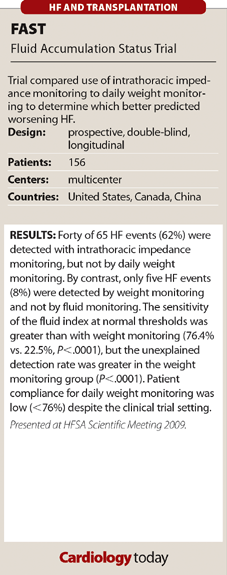FAST: Fluid index more accurate than weight monitoring in predicting worsening HF
Daily weight monitoring was also associated with more false positives than fluid monitoring.
Heart Failure Society of American 13th Annual Scientific Meeting
The use of intrathoracic impedance monitoring is more accurate in predicting worsening HF than daily weight monitoring in patients with HF indicated for implantation of a cardiac resynchronization device or defibrillator.
Researchers for the FAST trial enrolled 156 patients with HF into the study. Patients with implanted CRT devices had impedance monitoring software downloaded into their devices, and all patients were given daily diaries to report their daily weight monitoring compliance. The primary endpoint of the study was worsening HF events defined as hospitalization, emergency room visits, urgent care or unscheduled office visits for worsening HF.
According to the study results, 40 of 65 HF events (62%) were detected with intrathoracic impedance monitoring, but not by daily weight monitoring. By contrast, five HF events (8%) were detected by weight monitoring and not by fluid monitoring. The sensitivity of the fluid index at normal thresholds was greater than with weight monitoring (76.4% vs. 22.5%, P<.0001), and the unexplained detection rate was greater in the weight monitoring group (P<.0001). In addition, patient compliance for daily weight monitoring was low (<76%) despite the clinical trial setting.
“The adjusted sensitivity for the fluid index is more than three times higher than with daily weight monitoring, and the adjusted unexplained detection rate is more than two times higher for daily weights,” concluded William T. Abraham, MD, a professor of internal medicine at the Ohio State University College of Medicine in Columbus, in his presentation. “So with daily weights, you have less sensitivity and more false alarms to respond to. In addition to daily weight monitoring, our daily standard of care, fluid status monitoring should be considered for routine use in patients with implanted devices that have this capability.”
In the discussant portion of the presentation, Lynn Warner Stevenson, MD, director of the cardiomyopathy and HF program at Brigham and Women’s Hospital in Boston, noted that weight measures should not be discarded entirely despite their limitations in helping predict the progression of HF.
“Perhaps we need to be more concerned that a patient who feels bad with a stable weight may yet be deteriorating, and a patient whose diuretics are not decreasing a weight gain may have gained fact and not fluid,” she said in her presentation. “Different signals may be useful to monitor different time intervals and different risk levels. Unfortunately, one out of every three Medicare dollars is going to take care of patients with HF, so we do not have much time to get it right. FAST is not enough – we need faster.” – by Eric Raible

For more information:
- Abraham W. LBCT I. Presented at: Heart Failure Society of America 13th Annual Scientific Meeting; September 13-16, 2009; Boston.
